It’s mid-morning on a sunny day and Yvette Yaa Konadu Tetteh’s arms and legs barely make a splash as she powers along the blue-green waters of the River Volta in Ghana. This is the last leg of a journey that has seen Tetteh cover 450km (280 miles) in 40 days to become the first person known to swim the length of the waterway.
It’s an epic mission but with a purpose: to find out whatis in the water and raise awareness of pollution in Ghana.
As the 30-year-old swims, a crew shadows her on a solar-powered boat, named The Woman Who Does Not Fear, taking air and water samples along the way that will be analysed to measure pollution.

It is hoped that the swim will draw attention to some of the pristine environments in Ghana, in contrast with places such as Korle Lagoon in the capital city of Accra, one of the most polluted water bodies on Earth.
“I want people to understand and appreciate the value we have here in Ghana,” says the British-Ghanaian agribusiness entrepreneur. “The only way I can swim is because the waters [of the Volta River] are hopefully clean. Korle Lagoon was once swimmable but now you wouldn’t want to touch any of it.”
The swim is supported by the Or Foundation, of which Tetteh is a board member, that campaigns against textile waste in Ghana, one cause of increasing water pollution in the country.
Ghana imports about 15m items of secondhand clothing each week, known locally as obroni wawu or “dead white man’s clothes”. In 2021, Ghana imported $214m (£171m) of used clothes, making it the world’s biggest importer.


Donated clothes come from countries including the UK, US and China and are sold to exporters and importers who then sell them to vendors in places such as Kantamanto in Accra, one of the world’s largest secondhand clothing markets.
Kantamanto is a sprawling complex of thousands of stalls crammed with clothes. You can find items from H&M, Levi Strauss, Tesco, Primark, New Look and more. On display at one stall is a River Island top with a creased cardboard price tag showing that, at one point, it was on sale for £6 in a UK Marie Curie charity shop.
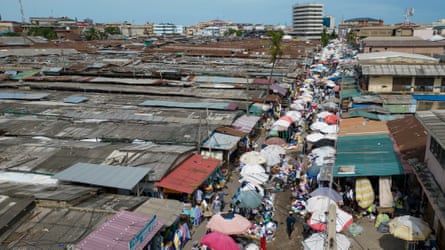
As fast fashion – cheap clothes bought and cast aside as trends change – has grown, the volume of clothing coming to the market has increased while the quality has gone down.
Jacklyn Ofori Benson is one of about 30,000 people who depend on the market for their livelihood. When the Guardian visits, she is furious. Earlier that morning, when she cut open her bale, she found it full of stained denim shorts.

“Today’s bale was very, very costly,” she says. “Most of the 230 items were rubbish; I noticed so many bloodstains. I’m really angry and have thrown all of them away.” To reinforce her point, she picks out other pairs of shorts with broken zips as well as stains that she has kept in the hope of someone buying them for a knockdown price.
In another section of the market, people work to repurpose items of clothing that would otherwise be discarded. T-shirts are cut up and sewn together with other bits of material to create skirts, knickers, tops and boxer shorts.
John Opoku Agyemang, the secretary of the Kantamanto Hard Workers’ Association, stands at his workstation cutting T-shirts into strips of material that he gives to seamstresses. He exports the resulting garments to other African countries, including Burkina Faso and Ivory Coast.


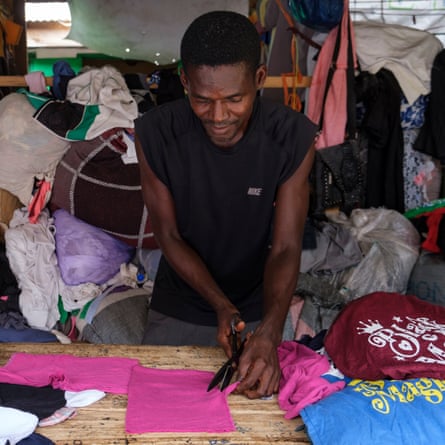
When he first started working at the market 24 years ago, he remembers being able to sell all the clothing that came in a bale. Now, when he opens one, there are about 70 items he can’t use, he says. “The problem of waste is getting worse. For 12 years, the goods coming here have not been good, we can’t benefit from them. It’s my impression that countries abroad think Africa is very poor so they give us low-quality goods and their waste.”
According to the Or Foundation, about 40% of the clothing in Kantamanto leaves as waste. Some of it is collected by waste management services, some is burned at the edges of the market, while the rest is dumped in informal landfills.
About two miles from the market lies Old Fadama, a once vibrant and thriving community that now resembles an apocalyptic hellscape. It is the largest unsanctioned dump for clothing waste leaving Kantamanto, the Or Foundation believes. The area is home to at least 80,000 people – many have migrated from northern Ghana where the climate crisis is affecting farming; their houses are built on layers of rubbish.


Animals graze on metres-high piles of clothes and plastic. A TV lies in the mud. Birds circle overhead while flies swarm close to the ground. Korle Lagoon is here; its waters are black and filled with excrement, its shores lined with litter. The air is hazy with smoke from fires burning waste. Rubbish collectors pick up plastic bottles, put them into sacks and carry them on their heads. No one smiles.
It wasn’t always like this. Alhassan Fatawu, a 24-year-old photographer, moved to Old Fadama as a child with his mother and remembers swimming in the lagoon and playing on its shores. “As it is now, I can’t go near the lagoon. It’s like a death pit. People used to fish there, there were a lot of canoes with people depending on the lagoon for their livelihood.”
He adds: “The last decade was mad [in terms of waste being dumped there] … It’s so upsetting.”
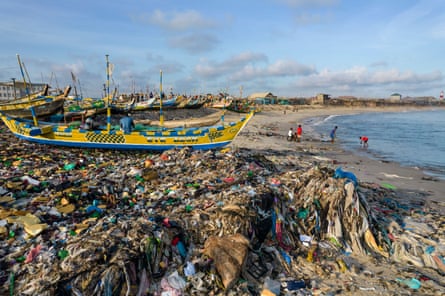
Korle Lagoon leads to the ocean. Waste is washed out to sea before some of it ends up lining the beaches of Accra. In Jamestown, one beach, next to a huge port development financed by China, is hemmed in by cliffs, which have clothes hanging off them. You can’t walk out into the waves without stepping over mounds of clothes and plastic waste.
At one end of the beach, Thomas Alotey sits on a boat mending fishing nets. He is resigned to his surroundings. “We want the situation to change but nothing will happen,” he says. “I know some of the clothes come from abroad but it is Ghana’s responsibility to dispose of the waste properly.”
He adds: “We are suffering. When I go out to fish, I come back with more clothes in my nets than fish.”
About 80 miles to the east, where Tetteh started the final leg of her swim, the scene could not be more different. The water is clean and enticing; the banks of the river are lined with palm trees and sandy beaches, and there’s only the odd canoe for company.
“There are parts that have been just sublime,” says Tetteh of her journey. “We came across small, sandy islands surrounded by super-calm, still waters against brilliant blue skies. The vistas are incredible.”
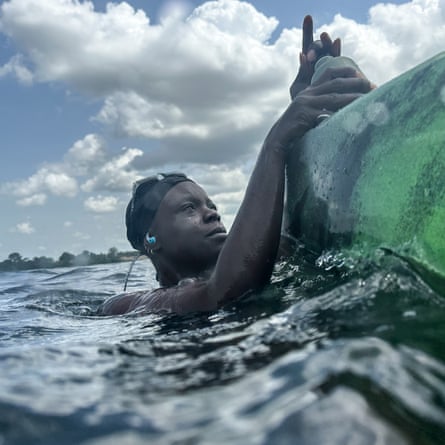
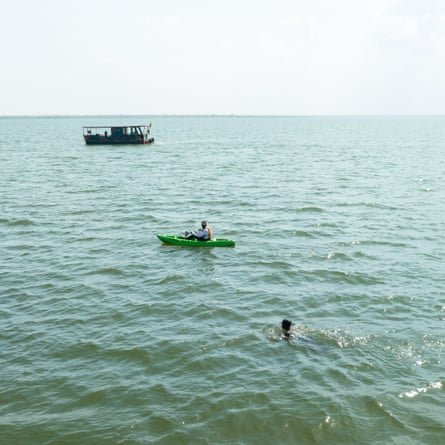


The crew’s journey has not been without challenges, however. There were nights spent on stormy waters in the middle of Lake Volta, the world’s largest artificial reservoir, because the boat ran out of power; tsetse flies, known to cause the potentially fatal sleeping sickness, hovered ominously round the crew; the boat got stuck in mud and it took the four-person crew along with a team of fishers three hours getting it afloat; and strong currents and lively waves made swimming almost impossible at times.
But, just before 6pm on 17 May as the sun set and the sky took on hues of orange, yellow and red, Tetteh swam towards the shore in Ada, where the River Volta meets the Atlantic Ocean. A crowd gathered to cheer her on and welcome her. She walked out of the water to a soundtrack of traditional drumming, and was flanked by a pair of dancers who accompanied her as she was greeted by community elders. Ghanaian TV crews had come to capture her, and the crew’s, triumph.
“It’s extremely satisfying to have finished,” says Tetteh. “I was very excited when I could taste salt in the water. Before that, I thought I wasn’t going to make it.”
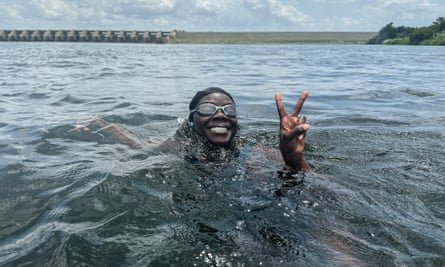
‘It’s like a death pit’: how Ghana became fast fashion’s dumping ground - The Guardian
Read More
No comments:
Post a Comment